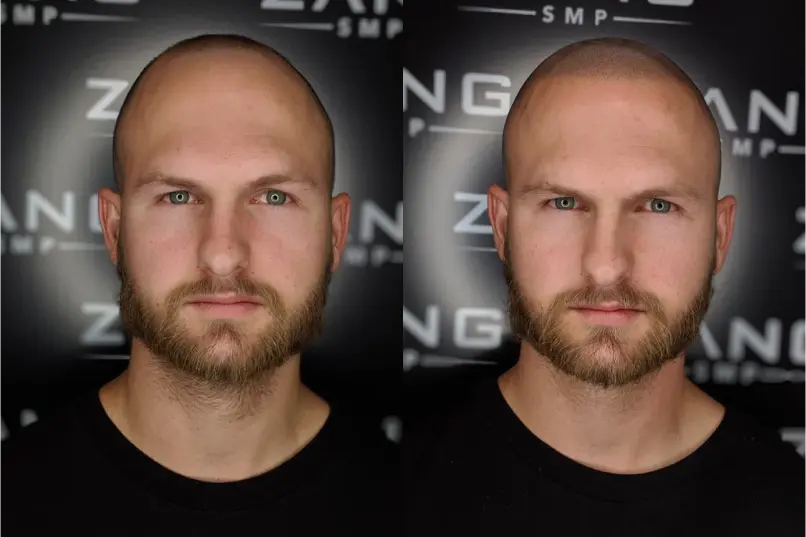Comparing Scalp Micropigmentation (SMP) with Other Hair Loss Treatments
Reviewed by Zang and Ridwan
A full head of hair is not just a crowning glory; it’s deeply intertwined with our sense of identity and confidence. However, for millions worldwide, thinning hair is an unavoidable reality. But with advancements in the field of hair loss, several treatments have emerged promising to slow down, stop, or reverse the process.
What is Scalp Micropigmentation (SMP)?
Scalp Micropigmentation creates a permanent shaved/buzzed look that is natural and accepted in all social circles. This treatment is similar to a tattoo, except that the needles, machine, and pigment are specifically designed for scalp micropigmentation. Additionally, while traditional tattoos are placed five layers or more into the skin, SMP is placed only two layers into the skin. This allows for the pigment to hold it’s follicle-like shape and provide clients with the natural buzzed appearance.
There’s little to no maintenance needed to preserve the look accomplished with SMP treatment.
SMP Procedure and Recovery
SMP is a highly specialized process where micro-needles are used to deposit pigment into the scalp's dermal layer, replicating natural hair follicles.
The recovery period for SMP is generally quick, with most people returning to their daily routine within a day or two. There might be redness or sensitivity in treated areas, but they tend to dissipate quickly, and the results, which start to become visible soon after the initial session, can be life-changing for many individuals.
Benefits of SMP
The benefits of SMP include:
- Immediate results
- No surgery required
- Low maintenance
- Can be used to camouflage scars
- Ability to create a variety of hairline styles
Comparing SMP with Other Hair Loss Treatments
Traditional hair loss treatments fall into two broad categories: surgical and non-surgical. Hair transplantation surgeries, such as Follicular Unit Extraction (FUE) or Follicular Unit Transplantation (FUT), involve the relocation of donor hair follicles from a donor site to the balding area. These surgeries are invasive and require post-operative care with a more extended recovery period.
Non-surgical treatments include medications such as Minoxidil and Finasteride, which are designed to slow hair loss and, in some cases, promote regrowth. However, these are topical or oral treatments and require consistent adherence to a prescribed regimen to achieve and maintain results.
Minoxidil (Rogaine) and Finasteride (Propecia)
These drugs tackle hair loss differently – Minoxidil is a topical solution that widens the hair follicle and stimulates hair growth, while Finasteride inhibits the formation of DHT, the hormone that shrinks hair follicles.
- Long-term daily use required
- Potential side effects
- Variable effectiveness depending on the user
Hair Transplants
Hair transplant surgery involves moving hair follicles from one part of the body (donor site) to bald or balding parts (recipient site). This can be in the form of follicular unit extraction (FUE) or strip harvesting (FUT).
- More invasive than SMP
- More expensive than some other options
- Typically a longer recovery period
- Natural hair regrowth and can be styled as naturally growing hair

Contemporary Treatments: Laser Therapy
Low-Level Laser Therapy (LLLT)
Devices that utilize low-level laser light to stimulate hair growth at a cellular level.
- Requires regular (often daily) use
- Can be used in combination with other treatments
- Some devices can be used at home
Cost Analysis
The cost of SMP can vary depending on several factors, including the extent of the desired coverage and the clinic’s location. It is generally more affordable than hair transplant surgeries, with typical full-head treatments ranging from a few thousand to several thousand dollars.
FUE and FUT surgeries represent a significant upfront investment, generally costing several times more than SMP.
For non-surgical treatments, the initial cost of the medications is relatively low, but when viewed over the long term, they can accumulate significant expenses. The costs are not only financial but also encompass the commitment of time and the potential for side effects.
Key Considerations Before Choosing a Hair Loss Treatment
Before deciding on treating your hair loss, it's crucial to consider various factors:
Cost and Long-Term Commitment
Most hair loss treatments are not one-time expenses – they require ongoing maintenance or might involve significant upfront costs. A cost-benefit analysis over time is important.
Personal Health and History
Particular treatments might not be suitable for those with certain health conditions or a history of specific illnesses. Always consult a healthcare professional to decide on options that align with your health status.
Lifestyle and Aesthetic Goals
The choice of treatment can hinge on your lifestyle, from the intensity of the maintenance routine to the nature of social downtime during recovery periods for more involved procedures.
If you're looking for a low-maintenance, non-invasive solution, SMP could be a great choice.
Treat your hair loss today with SMP.
